Riley Bailey
Russian forces have reportedly made notable changes to their command and control (C2) in Ukraine to protect command infrastructure and improve information sharing, although Russian force deployments are likely still exacerbating issues with horizontal integration. Center for Security and Emerging Technology (CSET) Deputy Director of Analysis Magarita Konaev and CSET Fellow Owen Daniels stated on September 6 that Russian forces moved headquarters out of range of most Ukrainian strike systems and have placed forward command posts further underground and behind heavily defended positions.[1] It is unclear if Russian forces have employed this more protected command infrastructure throughout Ukraine and to what degree these defensive efforts have impeded Ukraine’s ongoing interdiction campaign.[2] Konaev and Daniels stated that Russian forces have improved communications between command posts and units at the front by laying field cables and using safer radio communications.[3] The Royal United Services Insitute (RUSI) stated on September 4 that Russian forces are also trying to improve signals through the wider use of application-based C2 services that require less training.[4] Konaev and Daniels noted that signals at the battalion level downward are still often unencrypted and that Russian personnel still frequently communicate sensitive information through unsecure channels.[5]
Konaev and Daniels concluded that Russian forces still face challenges creating a horizontally integrated command structure to share information across different units in real time, a challenge the Russian military previously identified which has been exacerbated by Russia’s current force structure in Ukraine.[6] The Russian force grouping in Ukraine is comprised of both regular and irregular units, often deployed together and separate from their respective parent formations, further complicating efforts to horizontally integrate units. Russian forces in western Zaporizhia Oblast, for example, are notably comprised of elements of the 58th Combined Arms Army (Southern Military District), Russian Airborne Forces (VDV), Spetsnaz, naval infantry, irregular volunteer battalions, and brigades entirely made up of mobilized personnel.[7] Russian command is likely struggling to share information and create a common command space across these widely disparate forces defending against Ukrainian counteroffensive operations.
Artillery constraints in Ukraine are reportedly prompting the Russian military to accelerate longstanding efforts to implement a fires doctrine prioritizing accuracy over volume. Konaev and Daniels stated that Russian forces have tightened the link between reconnaissance systems and artillery units to improve fire accuracy, as Russian forces face growing constraints on their ability to leverage mass indirect fire.[8] RUSI noted on September 4 that Russian commanders are doubling down on the need to prioritize the development of a reconnaissance fires complex (RFC) due to assessing that existing Russian fires doctrine, which heavily relies on a high volume of fires and pre-established calculations of the density of fires needed to achieve certain effects, without a reliable system of rapid battle damage assessment, is non-viable.[9] Russian forces have long sought to implement the concept of RFC prior to the 2022 invasion of Ukraine, which dictates that Russian forces employ high-precision, long-range weapons linked to real-time intelligence data and precise targeting provided by an intelligence and fire-direction center.[10] RUSI added that Russian forces are prioritizing strike accuracy over volume because they lack the ammunition to sustain mass indirect fires, have difficulties transporting a large volume of ammunition to the frontline, and see diminishing effectiveness with mass strikes.[11] Russia is also reportedly increasing the production of Krasnopol laser-guided shells and Lancet drones (loitering munitions) to increase fires accuracy.[12] Russian units at the front are rapidly learning and innovating, but their ability to fully implement the desired RFC will likely be constrained by their ability to issue improved communications systems — and provide necessary training — to forces in combat.
Russian forces are additionally reportedly adapting their deployment of electronic warfare (EW) complexes. Konaev and Daniels stated that Russian forces have dispersed their deployment of EW complexes since spring 2022 from a concentration of roughly 10 EW complexes for every 20 kilometers of the frontline to 1 major EW system every 10 kilometers, with additional supporting EW assets deployed as needed.[13] The dispersal of these EW assets suggests that Russian forces have improved the coverage that a single EW complex provides, although Konaev and Daniels noted that the systems still have issues with limited coverage and EW fratricide.[14] RUSI stated that Russian forces are dispersing Pole-21 systems and treating them as disposable EW systems in order to provide wide-area protection from Ukrainian drone strikes.[15] Russian sources particularly credited superior Russian EW capabilities for aiding Russian forces’ successful defense against the start of the Ukrainian counteroffensive in southern Ukraine in June.[16] Konaev and Daniels added that these EW systems continue to present challenges for Ukrainian drones transmitting targeting information and securing Ukrainian signals.[17]
Ukrainian forces reportedly continued to advance south of Bakhmut and south of Robotyne in western Zaporizhia Oblast but did not make any confirmed gains on September 8. Ukrainian military officials reported that Ukrainian forces are continuing to advance south of Bakhmut and achieved unspecified successes south of Robotyne (10km south of Orikhiv).[18] One Russian milblogger claimed that Ukrainian forces advanced north of Andriivka (9km southwest of Bakhmut) and in Klishchiivka (7km southwest of Bakhmut), although another milblogger noted that the situation in Klishchiivka is unclear at this time.[19] Russian sources also claimed that Ukrainian forces seized positions on the northwestern outskirts of Novomayorske (18km southwest of Velyka Novosilka) on the Donetsk–Zaporizhia Oblast border.[20]
Russian forces conducted another series of Shahed-131/136 drone strikes targeting Odesa Oblast on the night of September 7–8. The Ukrainian General Staff reported on September 8 that Ukrainian forces downed 16 of 20 Shahed drones that Russian forces launched at grain and port infrastructure in Odesa Oblast.[21] Ukrainian Southern Command Spokesperson Captain First Rank Nataliya Humenyuk stated that Russian forces are launching drone strikes from Crimea in order to bypass Ukrainian air defenses.[22] Humenyuk also noted that the number of drones that Russian forces have launched and markings on the drones indicate that Russia has established domestic drone production.[23] ISW reported on September 6 that Russian authorities intend to expand domestic drone production beyond the Alabuga Special Economic Zone (SEZ) in the Tatarstan Republic into the Bashkortostan Republic.[24] Ukrainian Air Force Spokesperson Colonel Yuriy Ihnat noted that Russian forces may increase the frequency of drone strikes on Ukraine.[25] Romanian news agency Digi24 reported on September 8 that the Romanian National Committee for Emergency Situations authorized the General Inspectorate for Emergency Situations to issue warning and alarm messages where there are Russian drone attacks in the area.[26]
Russian Foreign Minister Sergey Lavrov publicly rejected an offer from the UN Secretariat that met many of Russia’s stated demands to rejoin the Black Sea Grain Initiative on September 6, indicating that the Kremlin is either delaying its return to the grain deal in an attempt to extract maximum concessions from the West or has no intention whatsoever of returning to the grain deal. Lavrov stated on September 6 that the Russian government received a letter from UN Secretary General Antonio Guterres offering several concessions in exchange for the resumption of the grain deal.[27] Lavrov stated and Reuters reported that the concessions in the letter included: reconnection to SWIFT for a Russian Agricultural Bank subsidiary in Luxembourg within 30 days, the creation of an insurance platform for Russian cargo and ships against Ukrainian strikes in the Azov and Black seas; the unblocking of Russian fertilizer assets in the EU, and approval for Russian ships carrying food and fertilizers to dock in European ports.[28] Lavrov publicly dismissed the UN Secretariat’s offer as a “workaround” that does not create a real solution to the problem.[29] Guterres stated on September 7 that the UN is “actively engaged” in attempting to improve Russia’s grain and fertilizer exports in order to convince Moscow to allow the safe export of Ukrainian grain through the Black Sea.[30] Reuters confirmed the existence of the letter and its contents on September 8.[31] The UN‘s letter notably offers concessions to most of the previously expressed Russian demands, with the exception of the renewal of operations for the Togliatti–Odesa ammonia pipeline as Lavrov noted on September 6.[32] ISW previously assessed that the Kremlin likely views the Black Sea Grain Initiative as one of its few remaining avenues of leverage against the West and has withdrawn from the deal and engaged in escalatory rhetoric to extract extensive concessions.[33]
Russian President Vladimir Putin reiterated boilerplate rhetoric justifying the current war in Ukraine while commemorating a Soviet military victory during the Second World War on September 8. Putin claimed that soldiers of the Donetsk and Luhansk People’s Republics’ (DNR and LNR) militias inherited their courage and resilience from ancestors who fought to recapture Donbas in the Second World War and reamplified the narrative falsely portraying the current Ukrainian government as “Nazis.”[34] Putin’s September 8 speech is a continuation of the rhetoric from his September 5 speech invoking the memory of significant Soviet military victories to set ideological conditions for a prolonged war effort.[35]
The Russian Ministry of Foreign Affairs (MFA) directly responded to recent indications that the Armenian government may be questioning its decades-long security relationship with Russia. The Russian MFA claimed on September 8 that it observed doubts within Armenian official circles and political elite about Armenian bilateral ties with Russia, trilateral Russian-Armenian-Azerbaijani ties, and ties to the Russian-dominated Collective Security Treaty Organization (CSTO). The MFA claimed that Armenian leadership has conducted “unfriendly actions,” including indicators that ISW recently identified: the provision of humanitarian aid to Ukraine, the visit of Armenian Prime Minister Nikol Pashinyan’s wife Anna Hakobyan to deliver the humanitarian aid to Ukraine, and Armenia’s decision to host joint military exercises with the United States.[36] The MFA also criticized Armenian leadership for moving to ratify the International Criminal Court (ICC) Rome Statute and stated that it issued a formal protest to the Armenian Ambassador to Russia, Vagharshak Harutyunyan, in response to these “unfriendly actions.”[37] The MFA’s direct response to these events indicates that Russian anger over indications of Armenian dissatisfaction with Russian security guarantees are not confined to the Russian ultranationalist information space but includes the Russian government.[38]
The US Department of Defense (DoD) announced a new security assistance package on September 7, providing Ukraine with $600 million worth of military equipment.[39] The DoD reported that the package includes: equipment to sustain Ukraine’s air defense systems, additional ammunition for HIMARS systems, 105mm artillery rounds, electronic warfare and counter–electronic warfare equipment, demolition munitions for obstacle clearing, mine-clearing equipment, and support and equipment for training, maintenance, and sustainment activities.
Unknown Russian actors may be helping Russian officials to censor Russian milbloggers who have previously criticized the Kremlin’s war effort in Ukraine. Supporters of imprisoned former Russian officer and ultranationalist Igor Girkin amplified an appeal from a Russian milblogger and serviceman Mikhail Polynkov who claimed that unknown individuals hacked into and stole access to his Telegram channel.[40] Polynkov claimed that these hackers began to impersonate him and are writing social media posts that contradict his opinions. Polynkov added that the hackers also published a post attacking another prominent milblogger (who advocates for veteran rights), unlisted many of his popular posts, and are trying to find information to blackmail him and his affiliates. Polynkov claimed that these hackers are not ordinary thieves who are attempting to scam his audience for money but instead are individuals who disagreed with his criticism of the Kremlin. ISW has recently observed several crackdowns against Russian ultranationalist veterans who consistently criticized the Kremlin likely as part of a centralized effort to silence some critical milblogger voices.[41]
Key Takeaways:
- Russian forces have reportedly made notable changes to their command and control (C2) in Ukraine to protect command infrastructure and improve information sharing, although Russian force deployments are likely still exacerbating issues with horizontal integration.
- Artillery constraints in Ukraine are reportedly prompting the Russian military to accelerate longstanding efforts to implement a fires doctrine prioritizing accuracy over volume.
- Russian forces are additionally reportedly adapting their deployment of electronic warfare (EW) complexes.
- Ukrainian forces reportedly continued to advance south of Bakhmut and south of Robotyne in western Zaporizhia Oblast but did not make any confirmed gains on September 8.
- Russian forces conducted another series of Shahed-131/136 drone strikes targeting Odesa Oblast on the night of September 7–8.
- Russian Foreign Minister Sergey Lavrov publicly rejected an incredibly favorable offer from the UN Secretariat that met many of Russia’s stated demands to rejoin the Black Sea Grain Initiative on September 6, indicating that the Kremlin is either delaying its return to the grain deal in an attempt to extract maximum concessions from the West or has no intention whatsoever of returning to the grain deal.
- The Russian Ministry of Foreign Affairs (MFA) directly responded to recent indications that the Armenian government may be questioning its decades-long security relationship with Russia.
- Russian forces conducted offensive operations along the Kupyansk-Svatove line, near Bakhmut, and along the Avdiivka-Donetsk City line but did not make any confirmed advances on September 8.
- The New York Times (NYT) — citing Western, African, and Russian sources — reported that Russian intelligence structures are competing for control of the Wagner Group’s assets and operations in Africa.
- Russian occupation officials continue to hold illegal regional elections in occupied Ukraine. Russian occupation officials in Donetsk, Luhansk, Zaporizhia, and Kherson oblasts announced the start of in-person voting in occupied territories on September 8.
- Russian Main Effort – Eastern Ukraine (comprised of two subordinate main efforts)
- Russian Subordinate Main Effort #1 – Capture the remainder of Luhansk Oblast and push westward into eastern Kharkiv Oblast and encircle northern Donetsk Oblast
- Russian Subordinate Main Effort #2 – Capture the entirety of Donetsk Oblast
- Russian Supporting Effort – Southern Axis
- Russian Mobilization and Force Generation Efforts
- Activities in Russian-occupied areas
Russian Main Effort – Eastern Ukraine
Russian Subordinate Main Effort #1 – Luhansk Oblast (Russian objective: Capture the remainder of Luhansk Oblast and push westward into eastern Kharkiv Oblast and northern Donetsk Oblast)
Russian forces continued offensive operations along the Kupyansk-Svatove line on September 8 but did not make confirmed gains. The Ukrainian General Staff reported that Russian forces conducted unsuccessful offensive actions near Synkivka (9km northeast of Kupyansk) and Novoyehorivka (16km southwest of Svatove).[42] Ukrainian Eastern Group of Forces Spokesperson Ilya Yevlash stated that Russian forces are continuing to concentrate efforts on the Novoyehorivka area and are using convict recruits and unspecified private military companies (PMCs) to conduct assaults in the area.[43] Ukrainian Deputy Defense Minister Hanna Malyar stated on September 7 that the operational situation in the Kupyansk and Lyman directions is intensifying.[44] A Russian milblogger claimed that Russian forces pushed Ukrainian forces off of unspecified heights near Novoyehorivka but that Russian forces have not established control over these positions.[45] A Russian news aggregator claimed that Russian forces continued to advance near Synkivka and Petropavlivka (7km east of Kupyansk) on September 7, although ISW has not observed visual confirmation of this claim.[46]
Yevlash stated that Russian forces aim to reach the Oskil River and capture positions near Borova (35km west of Svatove) before the start of the 2023–2024 winter, although the current localized Russian offensive along the Kupyansk-Svatove line is unlikely to achieve this objective.[47] The current localized Russian offensive effort on this sector of the front has achieved marginal gains and likely aims to draw Ukrainian forces away from more critical sectors of the front and Ukrainian counteroffensive operations instead of capturing tactically significant amounts of territory.[48] Russian forces would likely need to commit substantially more manpower to assaults along the Kupyansk-Svatove line to possibly achieve the alleged objective of reaching Borova. Yevlash stated that Russian forces continue to train and form assault units from previously defeated motorized rifle brigades and airborne (VDV) units in the area.[49] Yevlash also stated that Russian forces are using signalmen to form assault detachments, suggesting that recent heavy losses may be constraining available Russian manpower for assaults on this sector.[50] Ukrainian officials have previously noted that Russian forces are deploying elements of newly formed brigades and divisions to resume active offensive operations in the Kupyansk and Lyman directions, although ISW has not yet observed confirmation of these deployments.[51] Russian forces concentrated considerable manpower for months in this sector of the front before launching their unsuccessful winter-spring 2023 operational offensive effort, and ISW has observed no similar recent buildup in the area.[52]
Russian sources claimed that Ukrainian forces conducted unsuccessful ground attacks along the Svatove-Kreminna line on September 8. The Russian Ministry of Defense (MoD) claimed that Russian forces repelled five Ukrainian assaults near Novoyehorivka and Dibrova (6km southwest of Kreminna).[53] A Russian milblogger claimed that Russian forces repelled Ukrainian counterattacks near the Serebryanske forest area south of Kreminna on September 7.[54] Another Russian milblogger claimed that over the past two weeks Ukrainian forces advanced in the area of responsibility of the 27th Motorized Rifle Brigade (1st Guards Tank Army, Western Military District) in an unspecified area of the Lyman direction and that elements of the Russian 252nd Motorized Rifle Regiment (3rd Motorized Rifle Division, Western Military District) and the 237th VDV Regiment (76th VDV Division) later recaptured lost territory in the area.[55]
Russian Subordinate Main Effort #2 – Donetsk Oblast (Russian objective: Capture the entirety of Donetsk Oblast, the claimed territory of Russia’s proxies in Donbas)
Ukrainian forces continued offensive operations near Bakhmut on September 8 but did not make any confirmed advances. The Ukrainian General Staff reported that Ukrainian forces continued offensive operations and achieved unspecified partial success south of Bakhmut.[56] A Russian milblogger claimed that Ukrainian forces advanced north of Andriivka and in Klishchiivka, half of which the milblogger claimed that Ukrainian forces control.[57] A Kremlin-affiliated Russian milblogger claimed that the situation south of Klishchiivka remains unclear, however, and noted that sources are providing discrepant accounts of fighting in the area.[58] The milblogger claimed that Ukrainian forces intensified offensive operations along the Klishchiivka-Ozaryanivka (7-14km southwest of Bakhmut) line, and another Russian source characterized the situation near Andriivka as tense.[59] The Russian Ministry of Defense (MoD) claimed that elements of the Russian Southern Grouping of Forces repelled 12 Ukrainian attacks near Bakhmut, Vesele (20km northeast of Bakhmut), Orikhovo-Vasylivka (11km northwest of Bakhmut), and Andriivka (9km southwest of Bakhmut).[60]
Russian forces continued offensive operations near Bakhmut on September 8 but did not make any confirmed or claimed advances. The Ukrainian General Staff reported that Russian forces conducted unsuccessful offensive operations near Orikhovo-Vasylivka, Klishchiivka, and Andriivka.[61] Russian sources claimed that Russian forces conducted assaults near Zaliznyanske (12km northwest of Bakhmut), Orikhovo-Vasylivka, Klishchiivka, and Kurdyumivka (12km southwest of Bakhmut).[62] Prominent Russian milbloggers amplified footage claiming to show elements of the Russian 98th Guards Airborne (VDV) Division operating in the Bakhmut direction.[63] Ukrainian Deputy Defense Minister Hanna Malyar reported on September 7 that Russian forces are using various tactics in the Bakhmut direction in an attempt to distract Ukrainian forces and break up Ukrainian force concentrations.[64]
Ukrainian forces did not conduct any confirmed or claimed offensive operations along the Avdiivka-Donetsk City line on September 8.
Russian forces continued offensive operations along the Avdiivka-Donetsk City line on September 8 and reportedly advanced. Russian milbloggers claimed on September 7 and 8 that an assault group of the Russian 5th Brigade (1st Donetsk People’s Republic [DNR] Army Corps) captured a fortified area east of Krasnohorivka and that the 150th Motorized Rifle Division (8th Combined Arms Army, Southern Military District) advanced in Marinka in recent weeks.[65] Another Russian milblogger claimed on September 8 that Russian forces conducted unsuccessful assaults in Marinka and on the southern approaches to Avdiivka, however.[66] The Ukrainian General Staff reported that Russian forces conducted unsuccessful offensive operations near Avdiivka, Keramik (14km northwest of Avdiivka), Marinka (on the western outskirts of Donetsk City), Krasnohorivka (directly west of Donetsk City), and Novomykhailivka (10km southwest of Donetsk City).[67] Malyar reported that Ukrainian forces continue to repel Russian assaults in Marinka, preventing Russian forces from taking control of the settlement.[68]
Russian Supporting Effort – Southern Axis (Russian objective: Maintain frontline positions and secure rear areas against Ukrainian strikes)
Russian and Ukrainian forces engaged in limited skirmishes in western Donetsk Oblast on September 8. The Ukrainian General Staff reported that Ukrainian forces repelled Russian ground attacks south of Prechystivka (35km southwest of Donetsk City).[69] A Russian milblogger claimed that elements of the Russian 36th Motorized Rifle Brigade (29th Combined Arms Army, Eastern Military District) repelled a platoon-sized Ukrainian force northeast of Mykilske (27km southwest of Donetsk City).[70]
Russian sources claimed that Ukrainian forces intensified offensive operations and advanced along the Donetsk-Zaporizhia Oblast border on September 8. Russian milbloggers claimed that Ukrainian forces intensified offensive operations on the Novodonetske-Novomayorske line (12km to 18km southwest of Velyka Novosilka), and one milblogger claimed that Ukrainian forces captured positions on the northwestern outskirts of Novomayorske.[71] Some Russian sources claimed that Russian forces repelled Ukrainian attempts to cross the Shaytanka River immediately northeast of the Novodonetske-Novomayorske line.[72] The Russian ”Vostok” Battalion claimed that Ukrainian and Russian forces have exchanged control over some positions in the area and that the fighting is largely concentrated on the outskirts of an unspecified settlement (likely referring to Novomayorske).[73]
Russian and Ukrainian sources made various competing claims about the degree of Ukrainian activity amid reported Ukrainian advances in western Zaporizhia Oblast on September 8. The Ukrainian General Staff reported that Ukrainian forces achieved unspecified successes south of Robotyne (10km south of Orikhiv).[74] Some Russian sources, including the “Storm Ossetia” and “Alania” volunteer battalions defending in western Zaporizhia Oblast, claimed that Ukrainian forces conducted a “tactical pause” in the Robotyne area over the previous day to regroup.[75] Other Russian sources claimed that small groups of Ukrainian forces conducted unsuccessful mechanized and armored assaults against Robotyne on the morning of September 8.[76] Some Russian sources, including the Russian Ministry of Defense (MoD), claimed that Russian forces repelled Ukrainian attacks near Verbove (20km southeast of Orikhiv) from the northwest and Novopokropivka (16km southeast of Orikhiv) from the east.[77]
A Ukrainian official indicated that Ukrainian operations in Kherson Oblast may force Russian forces to draw reserves from occupied Crimea. Ukrainian Southern Operational Command Spokesperson Captain First Rank Nataliya Humenyuk stated that Russian forces suffer significant personnel and equipment losses from Ukrainian counterbattery activities in Kherson Oblast, limiting their combat effectiveness and likely forcing Russian forces to bring forward reserves currently operating in Crimea.[78]
Russian sources claimed that Russian forces continue to respond to Ukrainian raids on the Dnipro River delta. A Russian milblogger claimed that Russian forces pushed a small Ukrainian group off of Kozatskyi Island (west of Nova Kakhovka) following earlier reports of Ukrainian forces landing on the island on September 7.[79] Another milblogger claimed on September 8 that fighting continues on the Dnipro River delta islands and that Russian forces repelled another Ukrainian landing on an island opposite Nova Kakhovka.[80]
Russian Mobilization and Force Generation Efforts (Russian objective: Expand combat power without conducting general mobilization)
The New York Times (NYT) — citing Western, African, and Russian sources — reported that Russian intelligence structures are competing for control of the Wagner Group’s assets and operations in Africa. Unnamed Western officials stated that the Russian Foreign Intelligence Service (SVR) and the Russian General Staff Main Directorate (GRU) are trying to take over key aspects of Wagner financier Yevgeny Prigozhin’s operations in Africa and the information space.[81] Two unspecified officials noted that the SVR will likely absorb Wagner’s propaganda and disinformation outlets that Russia has used to target foreign countries, while the Russian Ministry of Defense (MoD) and the GRU will take over Wagner operations abroad. Western officials stated that GRU General Andrey Averyanov (reportedly the commander of the GRU‘s Unit 29155, which is reportedly responsible for international assassination and destabilization) is the likely candidate to oversee some of Wagner operations as part of an evolving system, which features multiple private companies (PMC).[82] NYT also reported that most Wagner forces remained in Africa despite some personnel deploying to Ukraine at the beginning of Russia’s full-scale invasion, and French intelligence estimated that 4,000 Wagner personnel were already stationed in Africa.
Russian milbloggers continued to criticize the Russian military command for failing to adequately protect Russian airfields against drone strikes. Russian milbloggers amplified footage on September 7 and September 8 which shows that Russian forces placed tires on top of military aircraft, presumably to protect the aircraft from drone strikes.[83] One milblogger claimed that the Russian commanders issued the order to protect Russian aircraft without having necessary infrastructure or means to do so.[84] A Kremlin-affiliated milblogger ridiculed the Kremlin’s claims that Russia built 16 hospitals in two months to address the COVID-19 pandemic in 2020 but cannot build hangars.[85]
The Russian MoD continues efforts to improve the Russian defense industrial base (DIB) to support the war effort. A Russian milblogger reported that Russian “Kurganmashzavod” machine-building plant sent another batch of new and repaired Russian BMP-3 infantry fighting vehicles to the Russian MoD.[86] The milblogger claimed that “Kurganmashzavod,” including its Volgograd site, have already exceeded the volume of combat vehicles produced in 2022 by 120 percent in eight months. The milblogger claimed that “Kurganmashzavod” is also producing 30 times more additional protection kits (including gratings and armored screens) in 2023 than in 2022. A Russian opposition outlet, however, reported that the Russian rubber industry cannot produce enough rubber to replace worn tires.[87]
Cuban officials reportedly arrested 17 individuals on charges related to a human trafficking ring that lured Cuban men to serve in the Russian Armed Forces.[88] Cuban Interior Ministry official Cesar Rodriguez stated that the ring’s leader relied on two people residing on the island to recruit Cubans to fight in Ukraine.
The Russian Cabinet of Ministers approved a simplified procedure on September 8 for issuing death and missing persons certificates to Russian servicemen fighting in Ukraine.[89] The new procedure will allow military commanders to issue these certificates, despite previously requiring medical professionals to provide such documents. Russian military commanders will need to report the death of servicemen to Russian registry offices, which would allow relatives to receive financial support at a faster rate — a common complaint of the families of deceased Russian servicemen throughout the war in Ukraine.
An IRGC-affiliated commercial airliner flew to Russian-occupied Crimea on September 7, possibly to transfer military materials and/or personnel to Russian forces there.[90] The airliner is operated by Pouya Air, which the United States and European Union have sanctioned for transferring military materials throughout the Middle East on behalf of the IRGC.[91] Pouya Air denied that the airliner was in Crimea and was “helping Russian forces.”[92] The Ukrainian military has accused Russia of using the Chauba training ground in Crimea to launch Iranian Shahed-131 and -136 drones against Ukrainian targets.[93] The flight to Crimea is particularly noteworthy given that Israeli and Ukrainian media have reported that Russia has experienced “logistical problems” in transporting Iranian drones from the Middle East to the frontlines in Ukraine.[94] Iran is helping construct a drone-manufacturing factory in Russia to resolve this problem, but the factory is not expected to be completed until at least early 2024.[95] The Pouya Air flight to Crimea comes after the IRGC and Lebanese Hezbollah trained Russian forces in Syria on how to operate Iranian drones on August 31, which the American Enterprise Institute‘s Critical Threats Project (CTP) previously reported.[96]
Activities in Russian-occupied areas (Russian objective: Consolidate administrative control of annexed areas; forcibly integrate Ukrainian citizens into Russian sociocultural, economic, military, and governance systems)
Russian occupation officials continue to hold illegal regional elections in occupied Ukraine. Russian occupation officials in Donetsk, Luhansk, Zaporizhia, and Kherson oblasts announced the start of in-person voting in occupied territories on September 8.[97] The Ukrainian General Staff reported that additional Federal Security Service (FSB) units arrived in occupied Donetsk City to monitor the regional elections.[98] The Ukrainian General Staff also reported that Russian and Belarusian propagandists arrived in occupied territories to positively cover Russian elections. The Ukrainian General Staff also reported that members of the Russian “election commission,” accompanied by Russian policemen and forces, are visiting locals and coercing them to sign ballots.[99] Russian occupation officials advertised free food near polling stations in occupied Kherson Oblast, and the Ukrainian Resistance Center previously reported that Russian occupation authorities are using free food to increase voter turnout.[100]
Russian officials continue to forcibly relocate Ukrainian children from occupied territories to Russia under the guise of medical treatments. Russian Federation Commissioner for Children’s Rights Maria Lvova-Belova claimed that Russian authorities transported two children from the Shakhtarske orphanage in occupied Donetsk Oblast to Moscow for medical treatment and rehabilitation.[101] Ukrainian Verkhovna Rada Commissioner for Human Rights Dmytro Lubinets reported that Ukraine returned nine Ukrainian children home from Russia and noted that Russia imprisoned some of these children after accusing them of planting an explosive on a bridge.[102]
Russian occupation officials are continuing to integrate occupation education facilities into the Russian education system. Luhansk People’s Republic’s (LNR) Head Leonid Pasechnik announced on September 8 that LNR, the Moscow-based National Research University Higher School of Economics, and LNR universities signed an agreement to further integrate occupied Luhansk Oblast into the Russian educational sphere.[103]
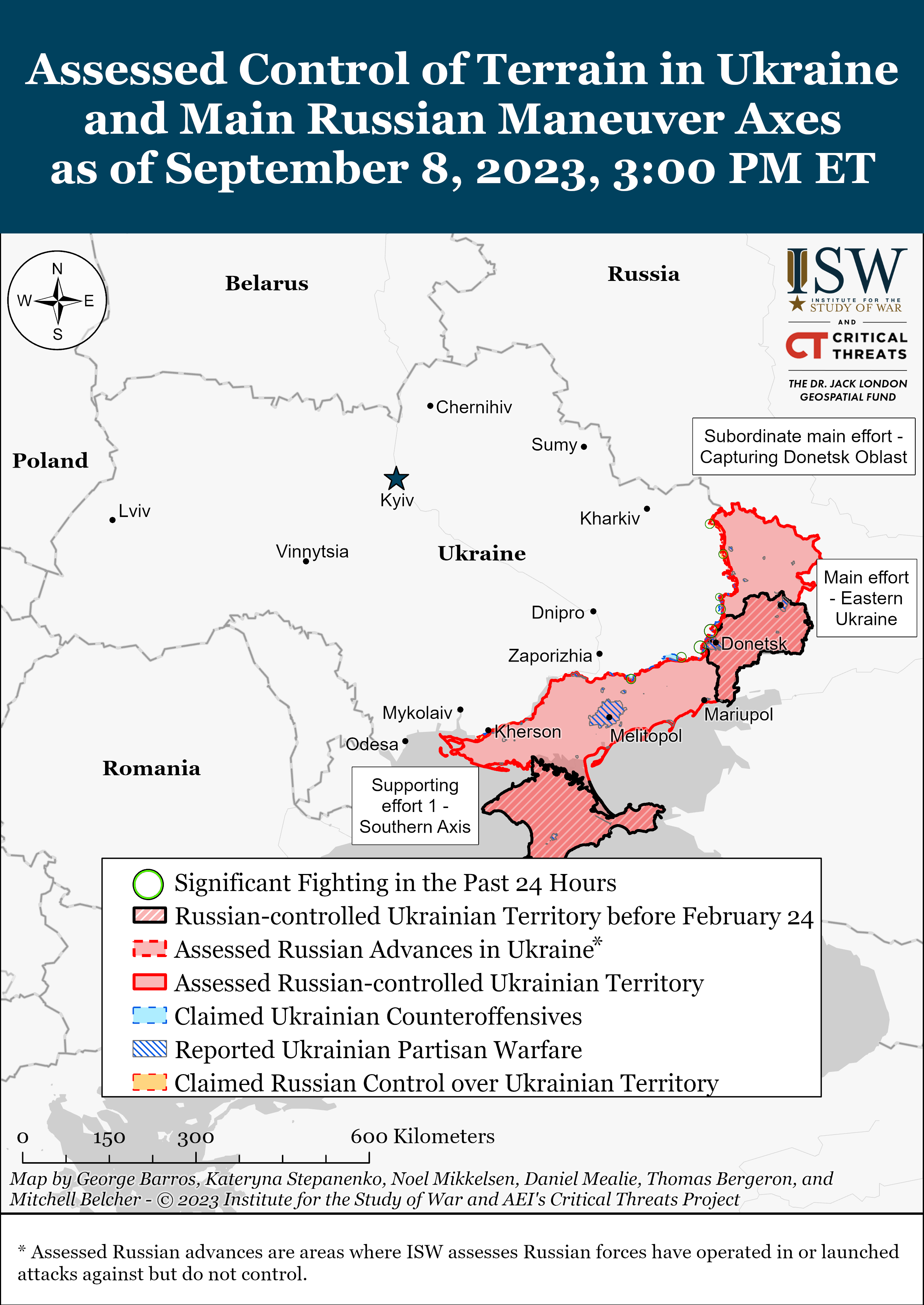
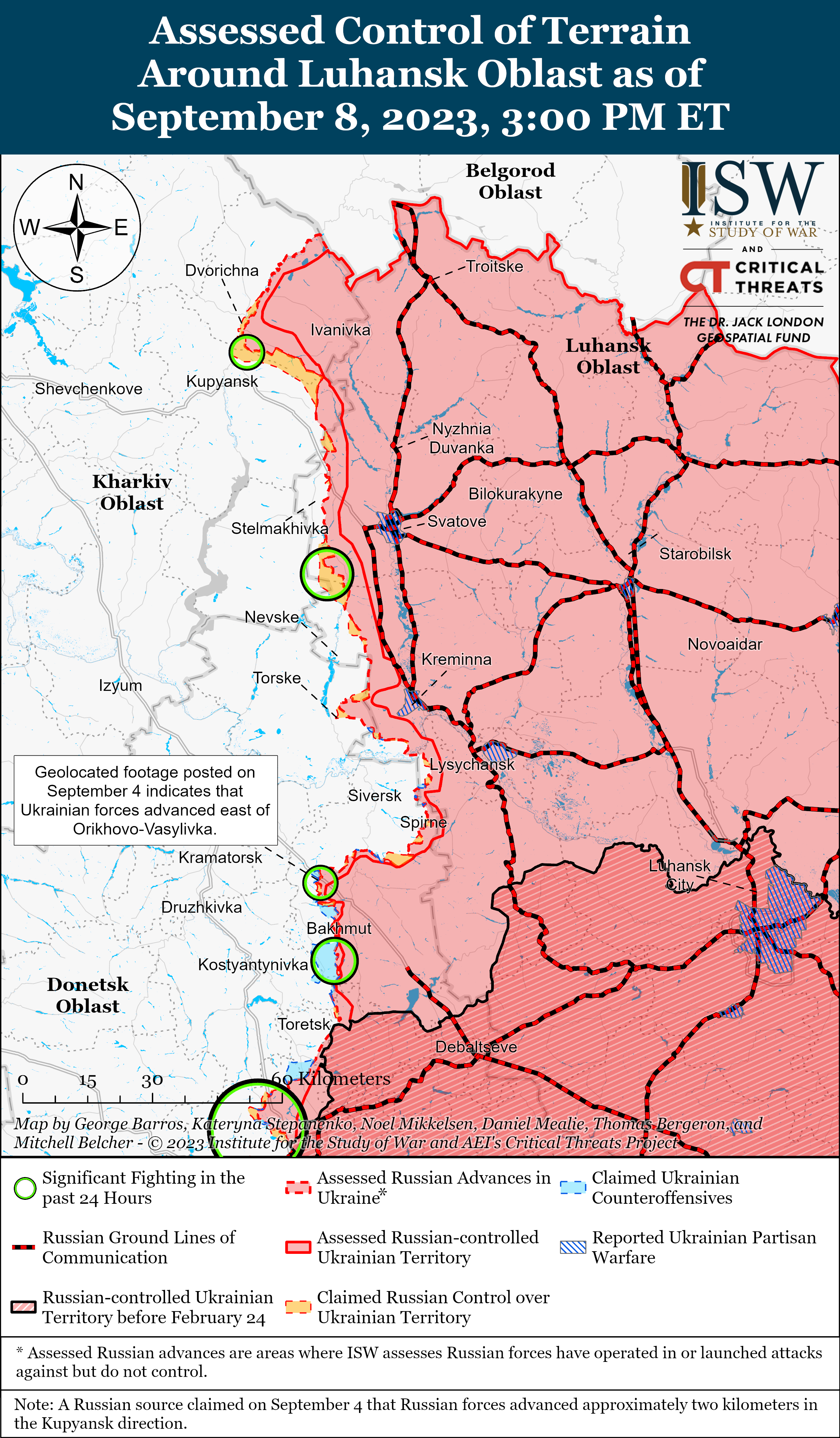
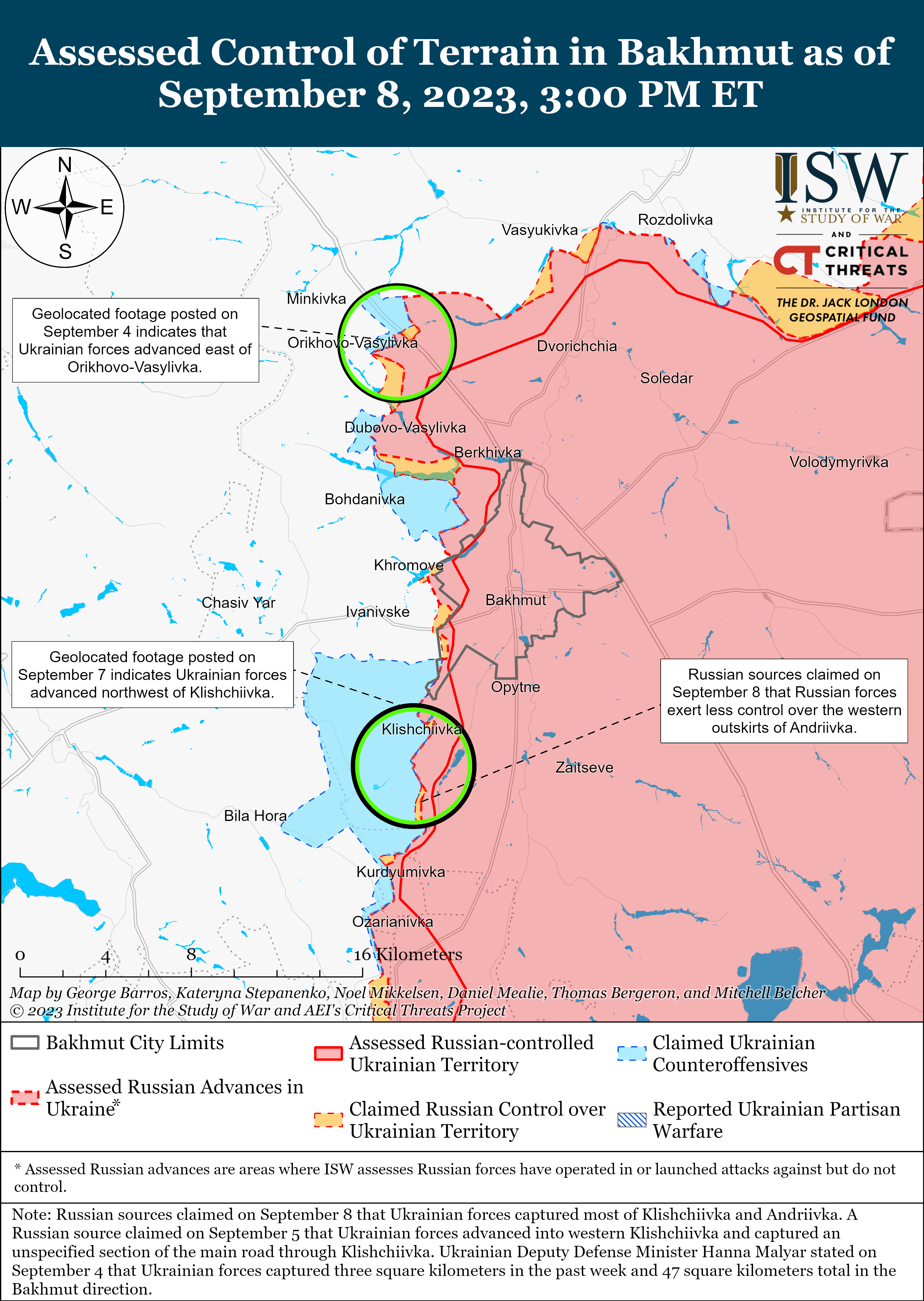
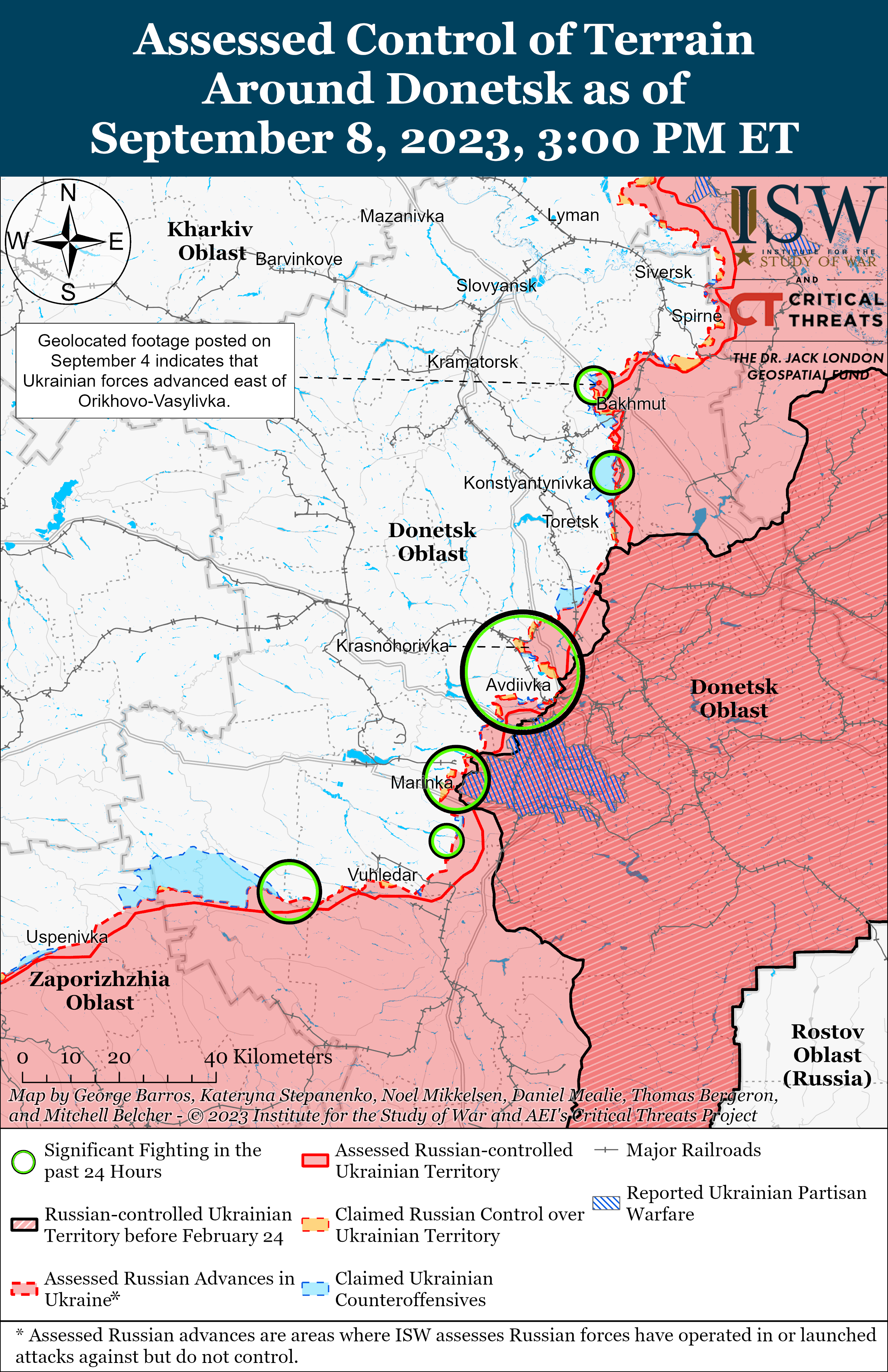
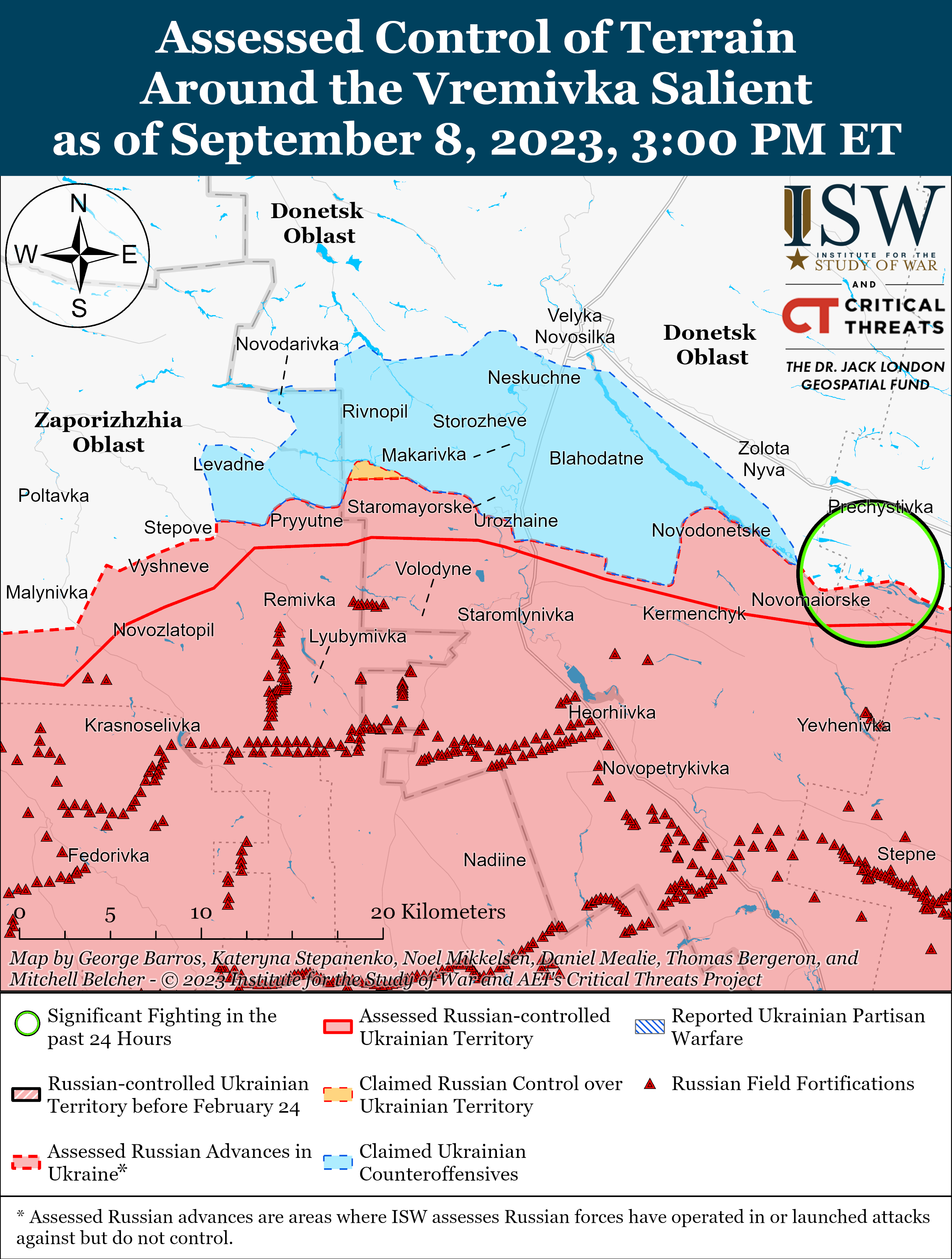
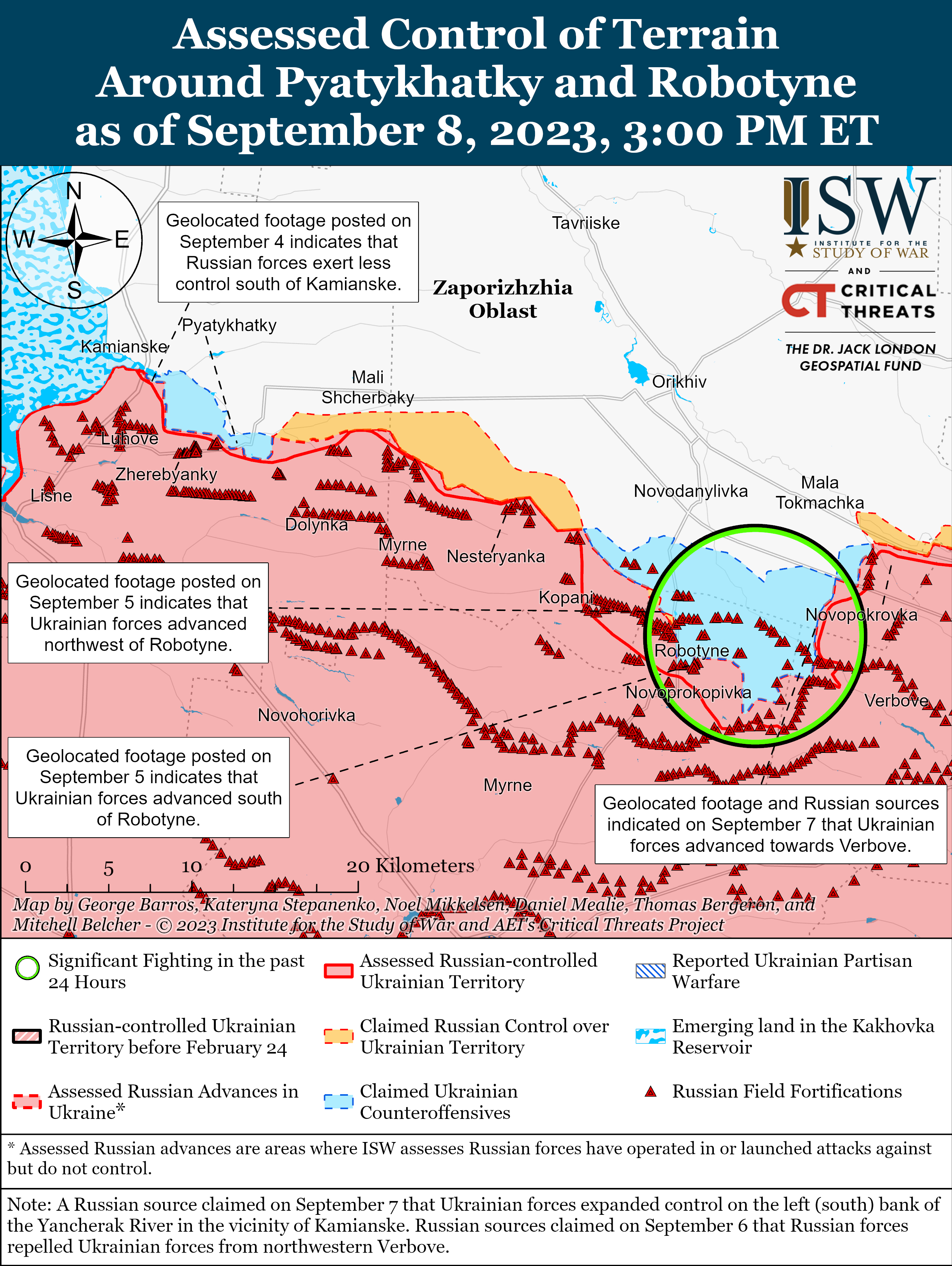
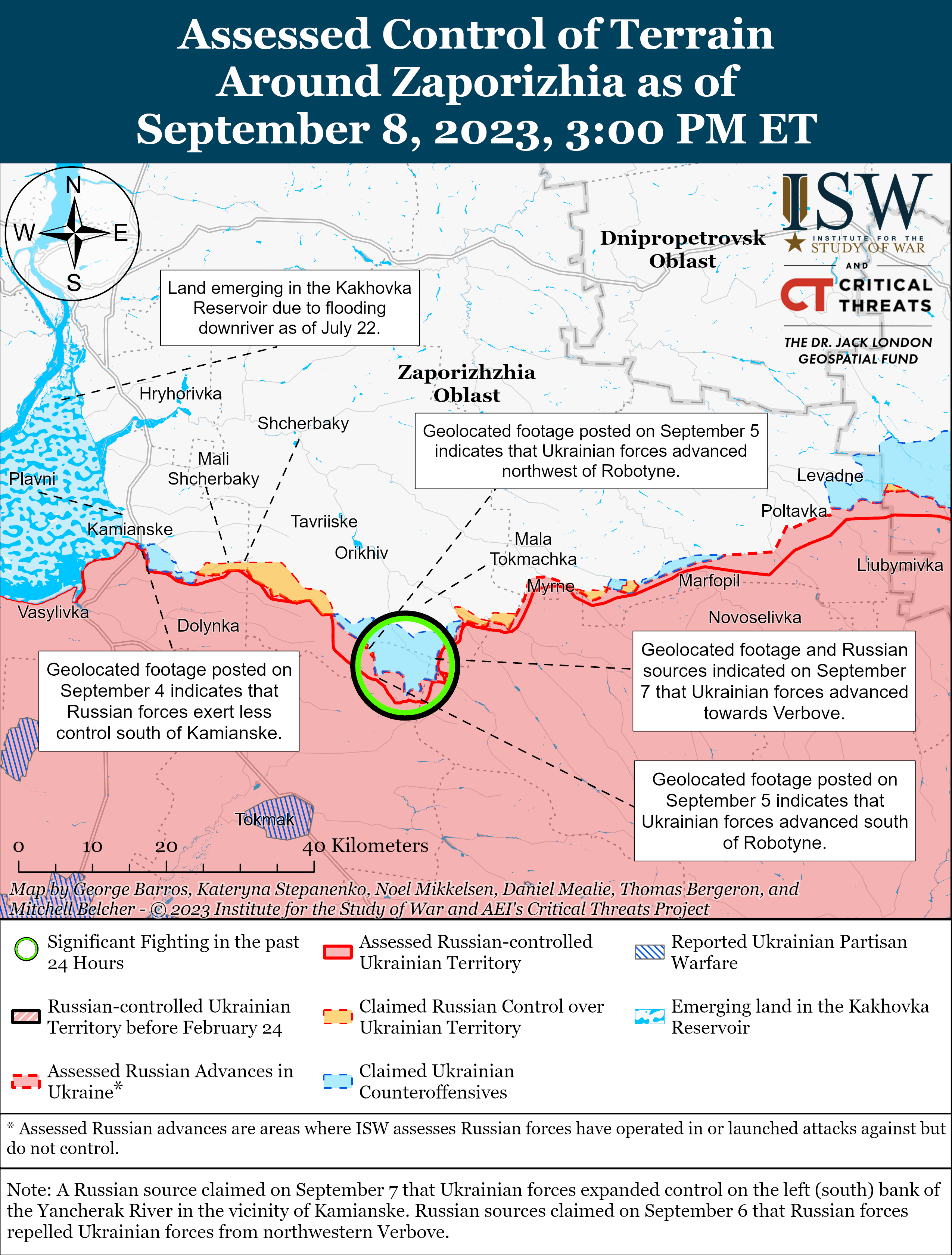
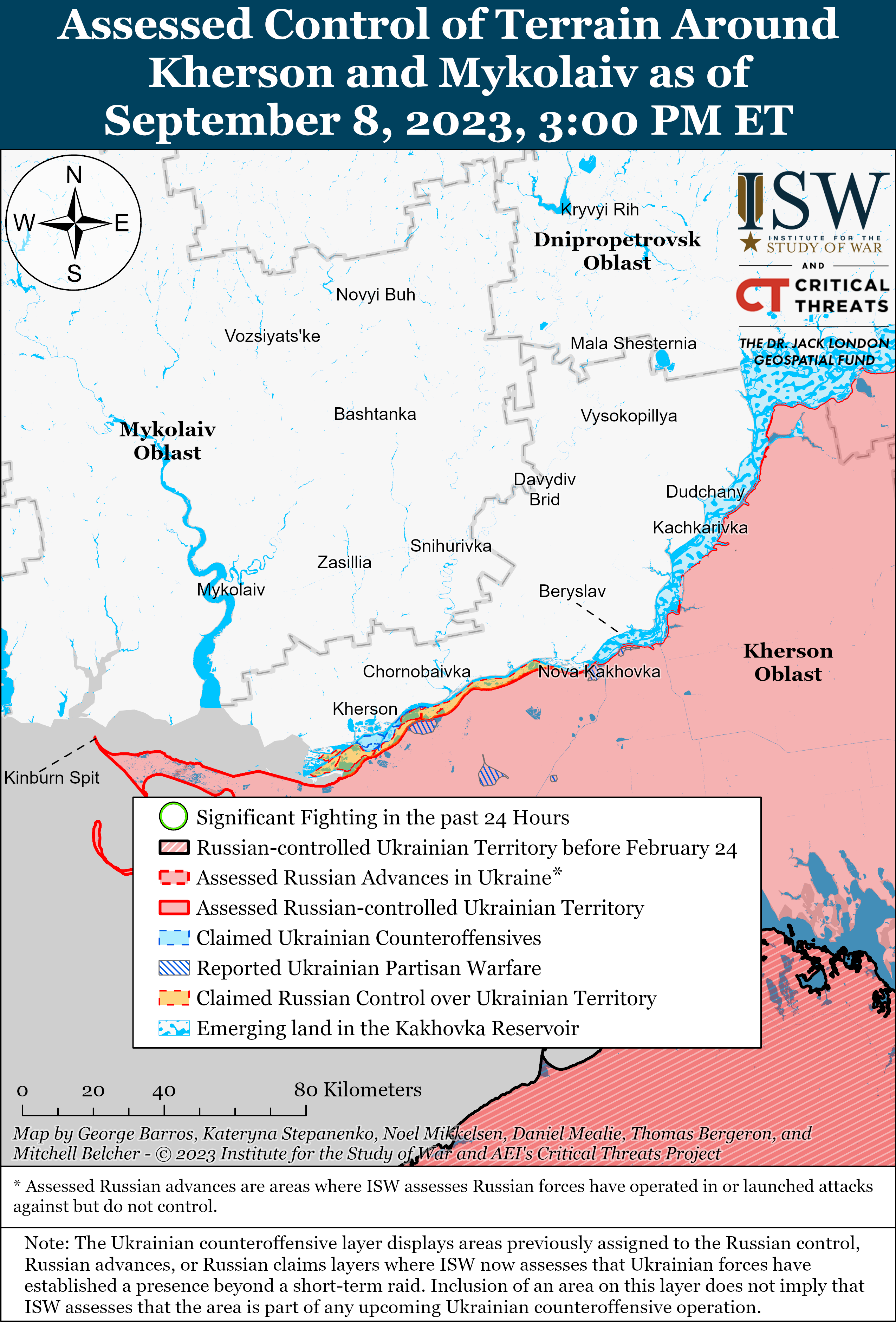
No comments:
Post a Comment